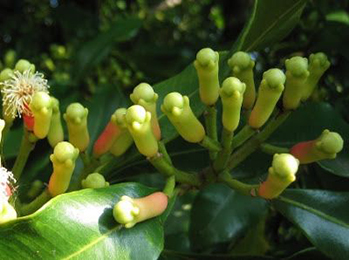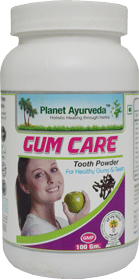Lavanga, Clove (Syzygium aromaticum)

Description of Plant
Lavanga (Syzygium aromaticum) is the medium-sized crown, bushy, evergreen tree growing up to 8-20 meters in height. Various parts of the tree like leaves and bark are aromatic but it is most famous for the aromatic flower buds. Leaves are simple, bright green and glossy. The lower surface of the leaves is covered in aromatic oil glands. Elliptical leaves with petioles can grow up to 13cm long along numerous short branches. Flowers forms in small clusters. Flower buds in the starting are pale with a glossy, fleshy appearance, turning green and become bright red as they turn mature. They consist long, narrow ovary which is approximately 1.5-2.0 cm in length with four small triangular sepals protruding outwards at one end. The sepals form the small ball of four overlapping petals which protect the developing flower parts inside. Then it is in the form of clove which is used as a spice. The clove is 1.5 to 2 cm long and consists of long calyx, 4 unopened petals and 4 sepals.
The fruits are 6 mm in diameter minute capsules with unctuous many angled seeds inside
General Information
Lavanga is also called as cloves. It is one of the most common species used in kitchen from ages. In Hindi clove is kwon as the Laung. From the ayurvedic perspective this herb has the great medicinal importance for the treatment of various ailments. This herb has the soothing and cooling effects on the stomach. Use of this herb is good for the morning sickness of pregnant women.
This herb contains the Eugenol which adds up to 70 to 90% of the Clove essential oil constituent. Other major phytochemical constituents are beta caryophyllene, methyl salicylate, kaempferol, acetyl eugenol, triterpenoids, gallotannic acid, rhamnetin, vanillin and eugenin. These biochemical chemical compounds are packed with antioxidant, carminative, antifungal anti-carcinogenic, immunostimulant, stomachic, anti-inflammatory digestive, antibacterial, decongestant, expectorant and aphrodisiac properties.
Classification
- Kingdom: Plantae
- Class: Equisetopsida
- Subclass: Magnoliidae
- Superorder: Rosanae
- Order: Myrtales
- Family: Myrtaceae
- Genus: Syzygium
- Species: Aromaticum
Habitat
This herb is found in Sri Lanka, Mauritius, Tanzania and Singapore. In India, it is mostly grown in Tamil Nadu and Kerala.
Names
- Latin Name: Syzygium aromaticum
- Hindi name: Laung, Lavang
- Sanskrit names: Devakusuma, Bhringanga, Shekhara, Shri Prasuna, Chandanapushpaka and Varija.
- Telugu name: Lavangamu, Karavallu
- Gujarathi, Kannada name: Lavanga
- Tamil name: Kirambu
- Malayalam name: Grampoo
Ayurvedic Properties
| Hindi / Sanskrit | English | ||
| Rasa | Tikta, Katu | Taste | Bitter, Pungent |
| Guna | Laghu, Snigdha | Physical Property | Light, Oily |
| Virya | Sheeta | Potency | Cold |
| Vipaka | Katu | Metabolic Property (After Digestion) | Pungent |
Effects on Doshas
It balances the pitta and kapha doshas.
Classical Categorization
| Charak Samhita | Sushruta Samhita | Vagbhata |
|
Nill |
Nill |
Nill |
Ancient Verse about Syzygium aromaticum

The Bhavprakash nighantu, edition of 2010: verse 58-59, page no- 219-221.
Lavang, Devkusum, Shrisangaya and Shirparsunak are the Sanskrit names of Laung. It is pungent and bitter in taste, light in nature, good for eyes, cold in potency and promotes digestive fire. It is digestive in nature and enhances taste. It manages the cough, pitta, blood disorders, thirst, vomiting, pain, hiccups and abdominal distention.
References
The Bhavprakash nighantu with elaborated Hindi commentary by Padmashri prof. K.C. Chunekar, edited by Dr. G.S. Pandey: verse 58-59, edition of 1998: page no- 219-221.
Practical uses of Syzygium aromaticum
- This isknown to be an effective herb to resolve the digestive problems like bloating, intestinal gas, nausea, stomach upset, distention and dyspepsia. It also helps to provide relief in heart burn, acidity and stomachache. Furthermore it helps to improve the digestion.
- Anthelmintic properties of lavang are good to clear the intestinal worms from body. It is also good to treat the various intestinal infections which are caused by bacteria, virus, protozoa and other pathogens which may lead to serious digestive problems like cholera.
- This is known to be an effective herb to resolve the respiratory disorders like cough, asthma, sinusitis, cold, sore throat, bronchitis, flu, whooping cough, fever and tuberculosis. It helps to clear the mucous and phlegm from the airways. Moreover it also helps to provide relief in the nasal congestion, chest congestion, coughing and shortening of breath.
- Use of this herb is quite good in the treatment of skin infections caused by bacteria, virus and fungi. Antiseptic properties of this herb are quite useful to fight against the various infections. This herb helps in the natural healing of wounds and also provides relief in the cuts, bruises, scabies, acne, prickly heat, insect stings etc.
- Massage of lavang oil on painful area, helps in alleviating the pain, and reduces the inflammation. Hence the use of this herb is quite good in the treatment of rheumatism and arthritis.
- This herb is packed with eugenol and its other derivative compounds like flavonoids, isoflavones, and flavones etc. These biochemical compounds help to maintain the bone density and also aids in retaining the mineral content in the bones. Hence clove is an effective remedy for preventing Osteoporosis.
- This is known to be a famous herb in toothache as it helps to provide relief in pain. Moreover use of this herb is good to resolve the various oral infections like Pyorrhea, Gingivitis, mouth ulcers and gum bleeding. Antiseptic properties of this herb help to fight against the bacterial infections.
Parts Used
- Flower Bud
Dosage
- 1-2.5 gram powder and 1-3 drops of oil.
Ayurvedic Products from Syzygium aromaticum in Planet Ayurveda
Lavang herb is used in the formulation of gum care powder. This herbal product is used to treat the various gum diseases like Pyorrhea, Gingivitis, mouth ulcers, gum bleeding.
Directions for use – Massage your teeth and gums gently with 3-6 gm powder twice daily. Rinse your mouth with lukewarm water after 2-3 minutes.





ವಿವರ ತಿಳಿಸಿ